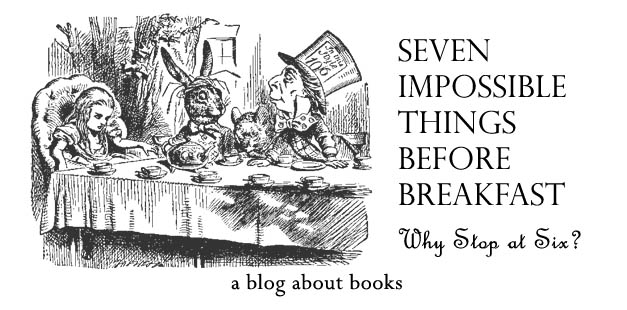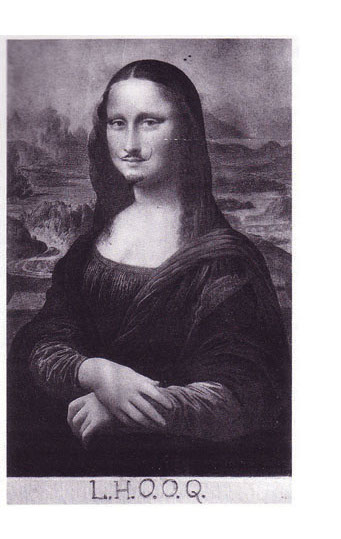In high school, my best friend and I would buy really bad romance novels and take a pen to them, re-writing the story in our own twisted ways. (Oh, how I wish I had kept at least one of those books.)
It’s certainly not a new idea. Many children, as picture book author Mac Barnett notes below, like to mess with books, deface images, channel their inner wise guy. When Mac and Jon Scieszka decided to join forces and create a picture book, Battle Bunny (Simon & Schuster), that looks as if a child has defaced an obscenely sweet story for children (think saccharine-sweet and totally hackneyed), it’s safe to say they had their work cut out for them. We simply haven’t seen the likes of such a picture book before–such a supremely subversive book, one that is essentially two stories being told simultaneously. (I’ve got an early copy of this book. I think it is scheduled to be released this Fall, though honest to Pete, I had thought it was this summer. I try not to post about books wildly early, but ah well. I’m forging ahead anyway.)
The underlying story? A bunny believes all his friends have forgotten his birthday, but in the end he’s given a surprise party. But along comes a child (so the reader is led to believe) with a marker, and this child has wreaked utter havoc on the story and artwork: That sweet birthday bunny is really a battle bunny, the kind who eats carrot juice brain juice and Carrot Crispies greasy guts for breakfast. And he’s actually not so sweet: He has an Evil Plan after all. (Make that birthday a doomsday, and off we go.) Many forest creatures try in vain to stop him. No worries: A boy, named Alex (the vandal we assume has put his pen to the sweet book) tries to stop the dastardly rabbit, and he has a few tricks up his sleeve, as well as a big secret (oh, and some assistance from the President).
Are you following all this? Yes, Jon and Mac wrote the sweet story first. The illustrator, Matthew Myers, illustrated said story. Then, they all got to work again. Defacing. Wrecking. Fun with disorder and disruption. Spray paint cans in hand. Mischief rules here.
I wanted to ask them precisely how they went about such a thing. All three of them. So, I did. I talked to Jon and Mac together, and then separately, I chatted with Matt. I did my best to weave it all together here. (In the process, incidentally, I discovered—thanks to Jon—that it is actually possible to read this book aloud, something I hadn’t thought do-able before. You gotta get a little help from your friends, but you can really and truly do it.)
Let’s get to it.
Jules: Jon and Mac, why this story now?
Jon: Mac and I both love really pushing the art of picture book storytelling. We had been messing around for quite a while, searching for something fun and odd and game-changing to challenge ourselves. We also both love sharing our stories with our kid audience, so we are always trying to make that book that will entertain/educate/electrify our readers.
After plenty of lame, dead-end ideas, the ultimate spark of inspiration came, as usual, when we weren’t really trying. We were just playing around. We were on a bookstore tour together. We found a certain very sincere book about a cat that we knew a friend of ours really hated. So we bought it, and in the back of the car, driving to the next bookstore, we took a Sharpie marker and started “improving” both the text and the illustrations
We laughed ourselves goofy.
And our “new” version of the story was so much better, so strange, so satisfying.
We both knew instantly that we had to find a way to do this for all of our readers.
After the fact, we realized this alteration storytelling was a perfect next step in messing with picture book narrative after the Three Pigs‘ unreliable narrator; the self-referential, deconstructed Stinky Cheese collection of stories; and the brain-bending Guess Again! reader interaction.
We also realized Bunny continued the Surrealist fun of Duchamp [pictured left is Duchamp’s L.H.O.O.Q., circa 1919], Dalí, Basquiat messing with the Mona Lisa [pictured above]… AND we had found a way to tell a story, using a mash-up remix technique.
But, most importantly, we knew we were doing something that almost every kid has done and would be inspired to do.
Mac: Digitization and the Internet have confounded a creaky copyright system, and we’re in a moment where artists are once again making remixes, pastiches, mash-ups, and such-like. But kids have known all along how fun it is to tweak intellectual property. A second-grader is a miniature modernist. When Jon and I visit schools, students will show us books they’ve messed with–comics–commentary scrawled in textbooks’ margins, vampire fangs on cuddly creatures, Gilbert Stuart’s portrait of Washington extended to reveal that the president isn’t wearing pants. Jon and I wanted to celebrate these kids as creators, who change something lifeless into art that works for them.
Jules: Mac and Jon, I saw the Politics and Prose panel where you talked about writing this. Can you elaborate? You wrote a cliché-filled children’s lit tale and then defaced it, yes?
Mac: Jon and I wrote this book (these books?) sitting on his back deck over a series of sunny afternoons in Park Slope. We started with an utterly worn-out storyline. Whenever I synopsize Birthday Bunny (the original, terrible book) for a bunch of kids, I say: “A bunny wakes up on his birthday. But none of his friends remember it’s his special day. He goes to the forest, and he sits on a stump, and he gets very sad, and what do you think happens at the end?” And then a chorus of bored kid-voices comes back in unison: “They throw him a surprise party.” It’s a pretty good axiom for a children’s book writer: Surprise parties are not surprising.
Birthday Bunny was made like a real book–Matt fully illustrated it, Simon & Schuster copyedited and laid out the text, and then Matt set to it with his pencil. And this version is the one we printed up by the thousands. But we’re making the original, unaltered story available to kids for free on a website, so they can make their own versions.
Jules: What was the most challenging part of writing such an unusual tale
Jon: We had to write both stories almost simultaneously. We consciously wrote the first Birthday Bunny story, setting up how we could twist it for the Battle Bunny story. Lots of back and forth with both the two stories–and how Matt would alter the illustrations, too.
Mac: And yet we couldn’t make it seem like we were gratuitously setting ourselves up for an easy joke in the Battle Bunny version. Birthday Bunny needed to work on its own as a conventional, tired, syrupy story.
![Matt: 'This is the final dummy sketch for a spread in the book. This is the way the whole dummy looked. Along with the dummy, I sent ‘tests’ (such as, the sheep and boy switching brains [pictured below])…' (Click to enlarge)](https://deeprootsmag.org/wp-content/uploads/2013/06/7imp-10.jpeg)
Matt: ‘This is the final dummy sketch for a spread in the book. This is the way the whole dummy looked. Along with the dummy, I sent ‘tests’ (such as, the sheep and boy switching brains [pictured below])…’ (Click to enlarge)
Jules: So, what was the most rewarding part of this?
Jon: That we got to write both stories simultaneously.
Also coming up with the lamest lines and action possible for Birthday Bunny.
Squirrel making his gift a “clock made out of nuts” is probably our finest hour.

Matt: ‘The original oil painting, about 25 inches wide. Note how the ‘R’ on the wooden sign is lighter, so I (or Alex) could replace it with an ‘S’ later. Also, in an actual illustration, meant to work as is, the interior of the cave would have been much darker and three-dimensional.’ (Click to enlarge)
Mac: When writing Birthday Bunny, our rule was we couldn’t spend more than a minute working out a story problem–the plot had to take the most banal and well-worn path to the finish. And so we got to the scene where the woodland creatures present Bunny with gifts, and I said, “What would a squirrel give a rabbit?” Jon immediately replied, “A clock made from nuts?” It made no sense and perfect sense, and we put it right in the story.
It was only much later that we saw the clock became the perfect time bomb during the final battle royal.
Jon: I also loved sneaking a nod to Beckett (”Must I hop on? I can’t hop on. I’ll hop on.”) into Bunny’s sad moment at his Special Thinking Place.
Mac: There’s Kafka, too, on page one–and a few other intertextual links to our favorites sprinkled throughout.
Matt: [Above] is the final book art [of the two images seen above]. Dan Potash, art director at S&S, aged the book and washed out the color. We didn’t want the pages to be glossy, because you can’t draw on fancy books. Or at least not with a pencil. To create this level, Dan sent me 11×17 prints on uncoated paper, and I drew over them with a pencil. I wanted the drawings to be close to actual reproduction size, so the roughness of the pencil would show up. In the areas I wanted lighter, I just erased the image. I used to erase the ink from books as a kid all the time.
I didn’t want to do all this digitally, because it never would have felt the same. There were many happy accidents that I never would have thought of: the uncontrollable pencil and eraser marks that real, imprecise tools make. For example, the “LUCKY RABBIT FOOT SMASH” is not really attractive, but it feels real. If I’d done it digitally, I just wouldn’t have been able to help myself–the erased area would have been much less muddy.
The only thing I wish we could have done differently with this book is have the kid make some spelling errors. This kid is a much better speller than me.
Jon: Discovering how best to read the book while sharing it with kids at Bank Street was another great moment. I found it works wonderfully best and strange and right as a duet–one sweet voice reading the Birthday text; one dark voice reading the Battle text. Simultaneously. It is the perfect aural duplication of seeing both stories simultaneously when you read it.
Jules: Mon and Jac (I already tried “Jon and Mac” and then “Mac and Jon”), can you talk about seeing Matt’s art for the first time? And was there a lot of discussion with him about how the hey this would work?
Mac: Matt messed around with actual books first for tests.
Jon: [Below is] our favorite.
Mac: There was a ton of discussion with Matt. He was very involved, starting from right after we finished the first draft. Matt would tell us where he needed another spread, or ask us if Badger could give Bunny a drum made from a log, instead of a pair of shoes made from roots. And when Jon and I saw how things were starting to look on the page, we’d go in and change, add, and excise. Back and forth, back and forth: The process was pretty insane and completely delightful.
![Matt: '[This is another] test I made (on existing art) to show everyone how I wanted to handle the vandalism.' (Click to enlarge)](https://deeprootsmag.org/wp-content/uploads/2013/06/7imp-14.jpg)
Matt: ‘[This is another] test I made (on existing art) to show everyone how I wanted to handle the vandalism.’ (Click to enlarge)
Matt packed in so many hidden jokes, so many elegant ways to change the saccharine into the chaotic. Months after getting the art, Jon and I would get on the phone and tell each other about the tiny jokes we’d just discovered.
He also did a series of artworks—long before we even wrote Battle Bunny–where he added images to oil paintings he bought on the sidewalk.
Matt: This…is one of my “Collaborative Works.” Mac and Jon saw them before we all met. You can find them on my site.
This book was a real puzzle. The color illustrations needed to leave room for the pencil drawings that would come but also work on their own, “pre-vandalism,” just as the original text needed to work independently. My biggest hurdle was to keep the original art free of craziness and evil. Knowing what the bunny would become made that difficult. I kept painting evil bunnies
Learning how to draw like a kid took a lot of memory-mining. Eventually, it all came back to me–the way I drew airplanes, the way I made explosions. Of course I had to forget everything I know about perspective. I drew with the pencil in-between the “wrong” fingers, to make my style less sure. Using my opposite hand didn’t give me enough control.
***
Jules here again.
Many thanks to these guys for visiting. For the record, Jon says he’s now working on a new middle grade series with Abrams, called Frank Einstein. “It’s an update,” he said, “a remix of the Tom Swift idea of connecting kids with real science in an adventure series. With a kid scientific inventor genius. And his two robot pals. And I have to go work on it right now.”
Bye, Jon.
Mac is also swiftly out the door: “I’m going to do an event in Cincinnati for my new book, Count the Monkeys, with REAL ZOO ANIMALS.” I think that real zoo animals are way more exciting, so I don’t blame him for hightailin’ it out of here.
And I completely and entirely forgot to ask Matt what he’s working on now–bad blogger, bad blogger–but I shall ask him and update the post later.
Until then …
BATTLE BUNNY. Text copyright ©2013 by Jon Scieszka and Mac Barnett. Illustrations copyright ©2013 by Matthew Myers. Published by Simon & Schuster, New York. Art and sketches reproduced with permission of Matthew Myers.
 This and many more of Jules’s adventures in books, kids’ lit and illustration can be found at her acclaimed blog, Seven Impossible Things Before Breakfast, where the above interview was published on June 14, 203. Visit often. It’ll do your body and soul good.
This and many more of Jules’s adventures in books, kids’ lit and illustration can be found at her acclaimed blog, Seven Impossible Things Before Breakfast, where the above interview was published on June 14, 203. Visit often. It’ll do your body and soul good.









![Matt: '[This is] a detail of the final bunny cover art…' (Click to enlarge)](https://deeprootsmag.org/wp-content/uploads/2013/06/7imp-8.jpeg)




